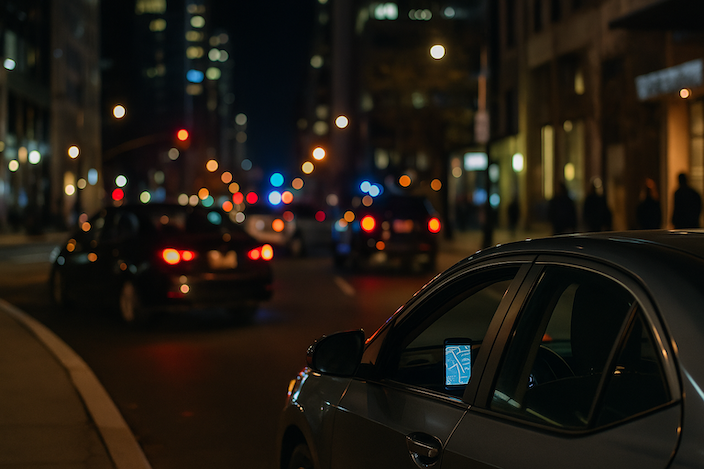Rideshare Wrecks: Uber/Lyft Insurance Tiers Explained

If an Uber or Lyft trip ends in a crash, which insurance pays—yours, the driver’s, or the rideshare company’s? The answer depends on the driver’s app status at the exact moment of impact. Maine law sets clear minimums for Transportation Network Companies (TNCs), and Uber/Lyft add their own coverage on top of those rules. Below, I break down each “tier,” what it covers, and how to protect your claim.
Maine’s baseline rules (why this matters)
Maine’s Insurance Code requires rideshare drivers—or the TNC on the driver’s behalf—to carry primary auto liability insurance that recognizes rideshare use. The statute also mandates uninsured and underinsured motorist (UM/UIM) coverage and forces the TNC’s insurer to step in from “dollar one” if the driver’s policy lapses or doesn’t meet the requirements. That means there should be no coverage gap once the app is involved.
The three coverage periods you need to know
Rideshare coverage hinges on the app’s status. Think in Periods 0–3 (sometimes 1–3 in industry lingo):
Period 0 — App OFF (personal use)
- What it means: The driver isn’t logged into Uber/Lyft.
- Who pays: Only the driver’s personal auto policy applies. Personal policies often exclude “livery” (for-hire) driving, but that exclusion doesn’t matter when the app is off.
- Maine angle: This is a standard car crash claim unless evidence shows the driver was actually online.
Period 1 — App ON, waiting for a request
- What it means: The driver is available, but hasn’t accepted a ride.
- Who pays: Uber/Lyft provide contingent third-party liability that activates if the driver’s personal insurer denies or doesn’t fully cover the loss. Typical limits are $50,000 per person, $100,000 per accident for bodily injury, and $25,000 for property damage. Because it’s contingent, expect pushback about which policy goes first.
Period 2 — Ride accepted, en route to pickup
- What it means: The driver accepted a trip and is driving to the rider.
- Who pays: Uber/Lyft provide primary liability up to $1,000,000 per incident (bodily injury and property damage combined). This is where the coverage jumps. Lyft+1
Period 3 — Passenger in the vehicle (active trip)
- What it means: The rider is on board until drop-off.
- Who pays: The same $1,000,000 primary liability applies. Many policies also include first-party benefits like UM/UIM and contingent comprehensive/collision for the driver’s car (deductible and eligibility vary). Maine law’s UM/UIM requirement supports this layer, which can matter if the at-fault driver is uninsured or flees.
Key takeaway: Once the app is ON, you’re never stuck with only a personal policy that excludes rideshare. Either the driver’s policy covers it or the TNC’s policy steps in under Maine’s statute.
What about the driver’s own car damage?
Uber and Lyft often offer contingent collision/comprehensive to the driver only if the driver carries those coverages personally. Deductibles commonly sit around $1,000. If you’re a passenger or another driver hit by the rideshare vehicle, this piece doesn’t affect your injury claim—but it can influence how quickly vehicles get repaired.
Why claims still get messy
Even with clear tiers, insurers fight over time stamps. A few seconds can move a crash from Period 1 (limited, contingent coverage) to Period 2 (full $1M primary). Expect disputes about:
- When the ride was accepted (app logs vs. recollection)
- Whether the rider was in the car (video, telematics, GPS)
- Which policy goes first (contingent vs. primary)
Independent sources—911 time logs, dashcam, bus/city cameras, telematics, and even phone screenshots—often resolve these arguments.
If you’re a passenger injured in a rideshare
You generally benefit from the $1,000,000 primary during Periods 2 and 3. If another driver caused the crash and has low limits, your claim may still flow through Uber/Lyft’s UM/UIM to make up the difference. This blended approach is common in serious cases.
If a rideshare hits you (driver, cyclist, or pedestrian)
Pin down the app status immediately. Ask police to note whether the driver was:
- Offline (Period 0),
- Online waiting (Period 1), or
- On a trip or en route (Periods 2–3).
Your attorney can send a preservation letter to Uber/Lyft for trip logs, GPS, and telematics to lock down the correct tier. Maine law also requires the driver to carry and disclose proof of TNC coverage after a crash, which helps you identify the right insurer faster.
Action steps after a rideshare crash
- Call 911 and get medical care.
- Photograph the vehicles, injuries, driver app screens (status, trip ID), and any dashcam prompts.
- Collect IDs and insurance for every driver—rideshare and non-rideshare.
- Capture witness info and nearby cameras (businesses, buses, homes).
- Note the timeline (accept time, pickup time, drop-off time).
- Avoid recorded statements until you understand which policy applies.
- Call a Maine injury lawyer who knows the TNC tiers and how to get the data quickly.
How our firm proves the right tier—and full value
We send immediate evidence-preservation demands to Uber/Lyft, pull telematics, confirm the exact app status, and identify all coverages (the driver’s policy, the TNC’s primary, any employer policy if the driver was also working, and your UM/UIM). We coordinate medical documentation and expert analysis and push back on “contingent coverage” arguments that shortchange victims. The result: the right insurer pays the full, tier-appropriate claim.
Injured in an Uber or Lyft crash in Maine? Peter Thompson & Associates can pinpoint coverage, prove liability, and pursue maximum compensation.
Free consultation. No fee unless we win. Call (207) 874-0909 or contact us online.

